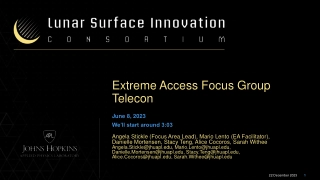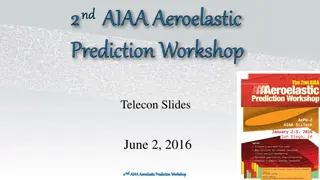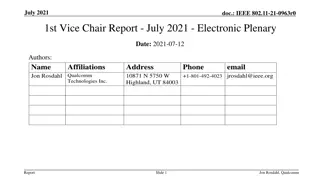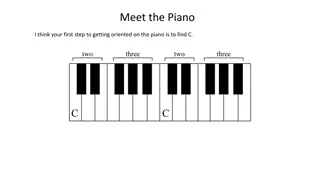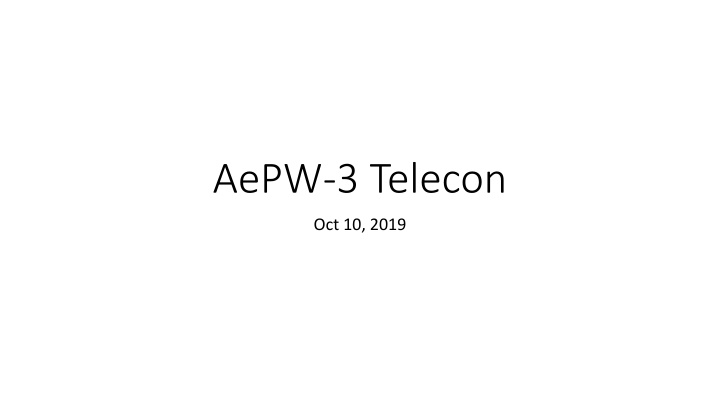
Aeroelastic Prediction Workshop 3 - Teleconference Notes and Group Updates
Stay updated on the latest developments from the Aeroelastic Prediction Workshop 3 teleconference held on October 10, 2019. Discover key discussions from the Large Deflection Group, Hypersonics Working Group, and more. Explore potential workshop problems, upcoming experiments, and member lists.
Download Presentation

Please find below an Image/Link to download the presentation.
The content on the website is provided AS IS for your information and personal use only. It may not be sold, licensed, or shared on other websites without obtaining consent from the author. If you encounter any issues during the download, it is possible that the publisher has removed the file from their server.
You are allowed to download the files provided on this website for personal or commercial use, subject to the condition that they are used lawfully. All files are the property of their respective owners.
The content on the website is provided AS IS for your information and personal use only. It may not be sold, licensed, or shared on other websites without obtaining consent from the author.
E N D
Presentation Transcript
AePW-3 Telecon Oct 10, 2019
Agenda: October 10, 2019 Hypersonics Working Group Large Deformation Working Group Notes: High angle of attack Working Group: Telecon to be held next Thursday Oct 17 at 11 am Inquiry made to AIAA-Applied Aero TC regarding possibility of discussion sessions at 2020 SciTech (Jan) and Aviation (June) conferences. No information yet. Website landing page is public facing now https://nescacademy.nasa.gov/workshops/AePW3/public/ Polls & Surveys Doodle poll https://doodle.com/poll/gbxvw3u4ispqetz5 Survey to scope and document interest and participation plans High Fidelity CFD workshop discussion planned for next telecon Next telecon Nov 7
Hypersonics FSI Working Group Telecon held on 10/04/2019. Attendees Duke University: Prof. Earl Dowell, Kai Bastos, Kevin McHugh USAFA: Adam Jirasek ATA Engineering: Eric Blades identified 4 potential classes of problems Control surface flutter Skin panel flutter Shock-boundary layer interaction driving a panel response ??? Control surface flutter, represented by a panel with free edges, seemed to be the most important in terms of mission success. Discussion regarding the goal of the workshop and how we identify a relevant workshop problem: select a challenging problem that can be solved using state-of-the-art methodologies and compare results to identify best practices, etc. or select one that pushes the SOA to identify deficiencies, shortcomings, and areas we need to improve. No consensus was reached. Discussion on upcoming or recent high-speed experiments that could potentially be used as the reference data for the workshop. The recent aerothermoelastic test conducted by the AFRL Structural Sciences Center at AEDC VKF C using a thin-panel is going to be limited distribution and thus not a candidate for an open workshop like AePW3. Experiments being conducted by Stuart Laurence (Univ. of Maryland), Andrew Neely (Univ. of New South Wales), DLR, Katya Casper (Sandia), and others were also mentioned, but unfortunately none of the experimentalists were able to participate. Follow-on discussion the next few weeks. No date has been set yet.
Moving Forward with the Aeroelastic Prediction Workshop 3 Large Deflection Group Notes for AePW-3 Telecon, October 10, 2019
Large Deflection Group: Members (mailing list as of October 2019) Member Facility Earl Dowell Duke University Kevin McHugh Duke University Maxim Freydin Duke University Kai Kruger Bastos Duke University Daniella Raveh Technion Moti Karpel Technion Arik Drachinsky Technion Rafael Palacios Imperial College Huub Timmermans NLR Jonathan Cooper University of Bristol Carlos Cesnik University of Michigan Roeland de Breuker TU Delft Jurij Sodja TU Delft Markus Zimmer DLR Johannes Dillinger DLR Markus Ritter DLR
Large Deflection Group: Organization A Large Deflection Group was launched within the community interested in a third Aeroelastic Prediction Workshop (AePW-3) This group will primarily focus on nonlinear aeroelasticity regarding large (nonlinear) structural deflections and their impact on the system The first Telecon of this group was held on September 25th: Motivations, topics, ideas, etc. were discussed and some test cases were presented The test cases from Duke University and Technion gained the most interest (see below) In the meanwhile, other configurations and a number of research topics centered around them were proposed and discussed via email The following slides show the currently most relevant experimental and simulation test cases
Duke University Aeroelastic Models Goals: Provide experimental data set to evaluate new nonlinear theoretical aeroelastic theories and computation methods Provide insights into nonlinear aeroelastic phenomena, such as flutter, LCO, and gust response High AR Wing Model: Made from steal spar and aluminum pieces/ribs (NACA 0012) with wood filling for aero shape Span 0.4508m, chord 0.0508m Slender body with masses to adjust torsional inertia to reduce natural torsional frequency Tests: Correlation studies for static aeroelastic response, flutter and LCO oscillations AePW benefits: Simple structural model Static and dynamic experimental data including LCOs Paper/Info: Tang and Dowell, Experimental Aeroelastic Models Design and Wind Tunnel Testing for Correlation with New Theory, Aerospace 2016
Technion Highly Flexible Wing Experimental Benchmark (in process) Goals: Generate a benchmark for static and dynamic (flutter) aeroelasticity of a very flexible wing. Will be used for validation of computational models and investigation of nonlinear aeroelastic phenomena. Gain experience with novel aeroelastic measurement techniques (optical fibers and motion tracking camera system) Model: Geometry: Chord - 100 mm, span - 550 mm Main spar: 550 X 60 X 2.5 mm, at the center-chord Airfoil - NACA0018, wing-tip rod for attaching weights Materials: Main spar - Aluminum 7075 Chassis - Nylon, PA12, 3D-printed Cover - Foil (Oralight, or the like) AePW benefits: Simple, low-cost design Can be shared and tested in several wind-tunnels FEM available (Ansys) Paper/Info: Avin et al., Design of an Experimental Benchmark of a Highly Flexible Wing, IACAS
University of Bristol High Aspect Ratio Wing Model (AWI-HARW) Goals: Explore static and dynamic aeroelastic behavior below flutter, but with LCOs due to geometric and aerodynamic nonlinearities Model: Semi-span = 2.4m, AR = 20, root chord = 320mm, taper ratio = 0.5 Aluminum alloy spar with foam sections and covering for aero shape Data sets: WT balance readings deflections from 3D Cameras strains and accelerations static pressures on one chordwise section unsteady pressures on one chordwise section Tests: Structural tests (including GVT) Static aeroelastic tests (max. tip deflection 25 % (w.r.t semi-span) Harmonic oscillations, push release Dynamic response with LCOs (in-plane bending and flow separation) Structural model/FEM? Paper/Info: Cooper et al., Wind Tunnel Testing of a High Aspect Ratio Wing Model, IFASD 2019
Interests and way forward Regarding these three test cases, we are interested in the investigation of several topics: Analysis of large static deflections (comparison of different theories and methods) Structural properties under preload due to large static deflection (changes in modal properties) Limits of linear methods (both structure and aero) Stability of the system about statically deformed aeroelastic shape (flutter, LCO) Hysteresis in LCO Impacts of nonlinear inertia effects on flutter/LCO (coupled in-plane and torsional motions at large deflections) Impact of aerodynamic nonlinearities (stall and flow separation at high AoA, low Reynolds numbers, necessity of high fidelity methods such as URANS) Interaction of aerodynamic and structural nonlinearities So far, most of us agreed to contribute to the Technion Benchmark Wing and the UoB AWI-HARW DLR and TU Delft offered to support collaborative experiments of the Technion Wing by testing this model in their wind tunnel (TU Delft would also do a GVT) There is also interest in flight dynamics of very flexible A/C, but this seems appropriate after the wing-only tests We will have another Telecon in the Large Deflection Group to decide upon the test cases we want to use and then develop a sequence of reasonable investigations
Moving Forward with the Aeroelastic Prediction Workshop 3 Telecon Notes Sept 9, 2019
Notes from Sept 12 2019 Telecon (Page 1/3) Next telecon will be on Oct 10 (rather than on Oct 3 which is the first Thursday) in recognition of German Unity (or Unification?) Day Webex: when the webex link comes up, there is an incorrect telecon number that is displayed. Reviewed the survey. 9 parties had responded. Discussion of expanding the survey. Jens added more categories on the fly. Bret reminded us that he was taking the lead on the google poll which would maybe help us to identify what product(s) do each of us want to get out of a workshop? Whereas the existing (and complementary) poll is more focused on what physics do we care about. Should the poll be expanded or does the current one make it easy to observe trends and extract data? Website landing page isn t public-facing yet, and it only contains telecon information currently. Please try to access it again next week.
Notes from Sept 12, 2019, (page 2/3) Steve Massey reviewed the experimental test cases that have been sent to him to date. (Steve s slides are included in these slides) High fidelity CFD workshop was mentioned and briefly discussed. We will ask Steve Wood, one of the organizers of that workshop, to discuss that workshop including planned test cases. Multi-purpose discussion: technical synergies, organizational aspects, possible participation Based on initial survey feedback, formed 3 ad hoc exploratory working groups.
Notes from Sept 12, 2019 Telecon (Page 3/3) Working groups- ad hoc exploratory phase groups? Large Deformation Working Group tentative membership (Carlos to coordinate initial email): Carlos Cesnik, Markus Ritter, Daniella Raveh, Jonathan Cooper, Earl Dowell, Kevin McHugh, Kai Bastos Hypersonics (Eric Blades to coordinate initial email): Eric Blades, Adam Jirasek, Kevin McHugh, Kai Bastos, Earl Dowell) Note that there may be interest from the High Fidelity CFD group. High angle of attack (Jen Heeg to coordinate initial email): Jen Heeg, and all those who have taken the survey except Markus (who is the only one who didn t select this as an area of interest) Expectations from these groups None? Item on the agenda of the next telecon to see if they have exceeded expectations Exchange emails or have discussions to try and find common ground, objectives, tests cases, other good things
Survey progress & path forward https://doodle.com/poll/gbxvw3u4ispqetz5 Suggest defining a suite of cases as shown for the high fidelity CFD workshop Possible collaboration and participation in high fidelity CFD workshop
Website progress https://nescacademy-s.larc.nasa.gov/workshops/AePW3/public/
Collaboration format Objective of workshops: Collaborate in an effective manner, getting the most return for time investment. Prior workshops were patterned after Drag Prediction Workshop. This is not a requirement, but rather has been a choice. We are free to make a different choice. Workshop and workshop process? Collaborative workspace that can naturally leads to a workshop?
Objectives of the Aeroelastic Prediction Workshop Assess the goodness of computational tools for predicting aeroelastic response, including flutter Understand why our tools don t always produce successful predictions Which aspects of the physics are we falling short of predicting correctly? What about our methods causes us to fall short of successful predictions? Establish uncertainty bounds for computational results Establish best practices for using tools Explicitly illustrate the specific needs for validation experimentation- i.e. why what we have isn t good enough Establish community for leveraging experiences and processes 18
Survey of unsteady aerodynamic experimental data sets Send technical reference papers on data sets acquired since 2005 Unsteady aerodynamics Flutter Buffet LCO Send to steven.j.massey@nasa.gov

